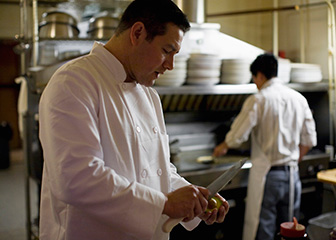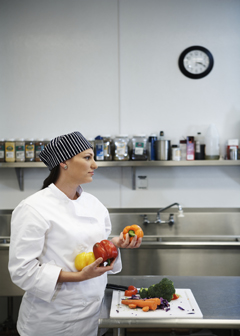
Cooks prepare fresh vegetables.
Cooks prepare, season, and cook a wide range of foods, such as soups, salads, entrees, and desserts.
Duties
Cooks typically do the following:
- Check freshness of food and ingredients before cooking
- Weigh, measure, and mix ingredients according to recipes
- Bake, roast, grill, broil, or fry meats, fish, vegetables, and other foods
- Boil and steam meats, fish, vegetables, and other foods
- Garnish, arrange, and serve food
- Clean work areas, equipment, utensils, dishes, and silverware
- Cook, hold, and store food or food ingredients
Large restaurants and food service establishments tend to have varied menus and large kitchen staffs. Teams of restaurant cooks, sometimes called assistant or line cooks, work at assigned stations equipped with the necessary types of stoves, grills, pans, and ingredients.
Job titles often reflect the principal ingredient cooks prepare or the type of cooking they do—vegetable cook, fry cook, or grill cook, for example. Cooks usually work under the direction or supervision of chefs, head cooks, or food service managers. For more information on these occupations, see the profiles on chefs and head cooks and food service managers.
Depending on the type of eating place, cooks use a variety of kitchen equipment, including broilers, grills, slicers, grinders, and blenders.
The responsibilities of cooks vary depending on where they work, the size of the facility, and the complexity and level of service offered.
The following are types of cooks:
Institution and cafeteria cooks work in the kitchens of schools, cafeterias, businesses, hospitals, and other institutions. For each meal, they prepare a large quantity of a limited number of entrees, vegetables, and desserts, according to preset menus. Because meals generally are prepared in advance, cooks seldom prepare special orders.
Restaurant cooks usually prepare a wide selection of dishes and cook most orders individually. Some restaurant cooks may order supplies, set menu prices, and plan the daily menu.
Short-order cooks prepare foods in restaurants and coffee shops that emphasize fast service and quick food preparation. They usually prepare sandwiches, fry eggs, and cook french fries, often working on several orders at the same time.
Fast-food cooks prepare a limited selection of menu items in fast-food restaurants. They cook and package food, such as hamburgers and fried chicken, to be kept warm until served. For more information on workers who prepare and serve items in fast-food restaurants, see the profile on food preparation workers and food and beverage serving and related workers.
Private household cooks plan and prepare meals in private homes, according to the client’s tastes and dietary needs. They order groceries and supplies, clean the kitchen, and wash dishes and utensils. They also may cater parties, holiday meals, luncheons, and other social events. Most private household chefs typically work for one full-time client.









